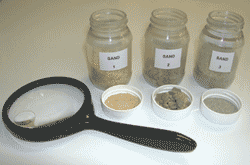| Approach: One
to one |
Level:
Year 4
and year 8 |
|
| Focus:
Geology
|
| Resources:
3 sand samples,
hand lens |
 |
388KB |
|
|
| Questions/instructions:
| Give
student hand lens and 3 sand samples.
Tip a small quantity of sand in each lid.
In this activity we’re going to look at different kinds
of sand.
You can have a close look at each of these sands now. |

[click on image for enlargement] |
|
| |
%
responses
2003 ('99) |
| y4
|
y8 |
1.
These sands were gathered from different places in New Zealand.
Where might you go to collect sand?
Prompt: Anywhere else?
|
ocean
beaches, estuaries, mudflats |
95
(98) |
98
(99) |
riverbeds,
banks, lakes |
24
(30) |
43
(48) |
deserts |
2 (6) |
4
(3) |
places
where there used to be a beach or river
(including commercial sandpits) |
2
(5) |
2
(6) |
quarries
where rock is ground up |
2
(0) |
4
(6) |
2.
How do you think sand is made?
|
by
rocks, stones, shells getting broken up |
36
(39) |
68
(52) |
Mechanisms:
(rubbing against each other – e.g. in river beds; wind action;
water/wave action) |
|
|
really
good account including at least 2 of these ideas |
0
(1) |
2
(0) |
mentioned
two ideas |
2
(5) |
7
(5) |
mentioned
one idea |
18
(18) |
35 (28) |
3.
I want you to have a good look at the sands.
Use the hand lens to help you.
Why are the sands different colours?
|
come
from different types/colours of rock/stone/shell |
20
(16) |
45
(30) |
vague,
but on right track
(come from different places) |
40
(41) |
36
(34) |
4.The
sands are different sizes.
Why are some pieces of sand big and some pieces of sand small?
|
different
materials and different stages of breakdown |
2
(2) |
9
(2) |
different
stages only |
20
(17) |
42
(31) |
different
types only |
11
(8) |
13
(11) |
|
|
|
|
Total
score:
|
8–11 |
4
(5) |
20
(13) |
5–7
|
22
(14) |
40
(27) |
2–4 |
53 (62) |
36
(47) |
0–1
|
21
(19) |
4
(13) |
Commentary
Year 8 students performed much better than year 4 students. While there
was little change between 1999 and 2003 for year 4 students, there was
a marked gain for year 8 students. |